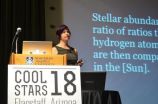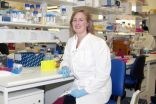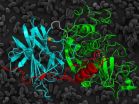(Press-News.org) TEMPE, Ariz. – An Arizona State University alumna has devised the largest catalog ever produced for stellar compositions. Called the Hypatia Catalog, after one of the first female astronomers who lived ~350 AD in Alexandria, the work is critical to understanding the properties of stars, how they form, and possible connections with orbiting planets. And what she found from her work is that the compositions of nearby stars aren't as uniform as once thought.
Since it is not possible to physically sample a star to determine its composition, astronomers study of the light from the object. This is known as spectroscopy, and it is one of the most important tools that an astronomer has for studying the universe. From it, researchers can often get information about the temperature, density, composition, and important physical processes of an astronomical object.
The digital catalog is a compilation of spectroscopic abundance data from 84 literature sources for 50 elements across 3,058 stars in the solar neighborhood, within 500 lightyears of the Sun. It essentially lists the compositions of stars, but only stars that are like the Sun – or F-, G-, or K-type (the Sun is a G-type star) – that are relatively near to the Sun.
"This catalog can hopefully be used to guide a better understanding of how the local neighborhood has evolved," explains Natalie Hinkel, who graduated from ASU in 2012 with her doctorate in astrophysics and is now a postdoctoral fellow at San Francisco State University (SFSU).
Putting together a catalog this large that is an accumulation of other people's work required a substantial amount of background research – compiling the first 50 datasets took her about six months. In total, the project took about two years. Hinkel started the project as part of her dissertation at ASU; however, a significant number of changes and revisions were done while at SFSU.
Vizier, a database where researchers can post their astronomical data, was a starting point but since not everyone posts their data online, many times Hinkel had to go to individual papers and transcribe the data by hand.
The Hypatia Catalog has a wide number of applications. The most obvious one for astronomers is looking at stars who host extrasolar planets, or exoplanets.
"Since 1997, we've known that stars with giant, Jupiter-like planets have quite a bit of iron in them. This result has been reproduced dozens of times. However, with a catalog of this magnitude, we can now study literally all of the other elements measured in stars in great detail to see if there are relationships between the presence of a planet (gaseous or terrestrial) and the element abundances," explains Hinkel.
Another example would be to look at the abundances of stars that rotate quickly versus those that rotate slowly, to see if there is a chemical relationship with their rotation speeds.
While constructing the catalog, Hinkel noticed that the stars in the solar neighborhood reveal unexpected compositions, which is discussed in the paper published in the September issue of the Astronomical Journal.
The Sun is in the disk of the galaxy, where the vast majority of the Milky Way's young stars are located. As the disk rotates, so too do the stars – both in the direction of the disk, as well as in smaller random motions.
"You can think of this like a swarm of bees: While the swarm in general moves, the bees themselves are going in all different directions. Because of this motion within the disk, the stars are considered to be well mixed – like a tossed salad. Therefore, you don't expect to see, for example, a whole tomato in your salad – or many stars that have similar abundances in close proximity to each other," explains Hinkel.
However, what Hinkel found is that the nearby 'solar salad' is comprised of lettuce at the bottom, chunks of tomato in the middle (where the middle of the galactic plane is), then lettuce again on top. In this case, the lettuce are stars that all have a high abundances of quite a few elements and the tomatoes are stars that have low abundances of those same elements.
In other words, the solar neighborhood does not appear to be a mixed salad; it's a layered salad.
"Given all of the motion in the galaxy, this was a very unexpected result. But it's also very exciting," says Hinkel.
INFORMATION:
The full catalog will be available via Hinkel's paper through the Astronomical Journal. The analyzed, reduced version will be made available through Vizier, which anyone is free to access.
Solar salad, anyone?
Determining stellar compositions made easier with new catalog
2014-08-19
ELSE PRESS RELEASES FROM THIS DATE:
Leukemia drug shows promise for skin, breast and other cancers
2014-08-19
MAYWOOD, Ill -- A leukemia drug called dasatinib shows promise for treating skin, breast and several other cancers, according to researchers at Loyola University Chicago Stritch School of Medicine.
Dasatinib fights leukemia by checking the uncontrolled growth of cancer cells. But when used against other cancer cells, researchers found, the drug employs a different strategy: It causes the cells to clump together, thus preventing them from migrating. Without the ability to migrate, cancer cells cannot metastasize (spread to other parts of the body).
Mitchell Denning, ...
Electroacupuncture attenuates neuropathic pain after brachial plexus injury
2014-08-19
Electroacupuncture has traditionally been used to treat pain, but its effect on pain following brachial plexus injury is still unknown. In a recent study reported on the Neural Regeneration Research (Vol. 9, No. 14, 2014), rat models of an avulsion injury to the left brachial plexus root (associated with upper-limb chronic neuropathic pain) were given electroacupuncture stimulation at bilateral Quchi (LI11), Hegu (LI04), Zusanli (ST36) and Yanglingquan (GB34). After electroacupuncture therapy, chronic neuropathic pain in the rats' upper limbs was significantly attenuated. ...
Genetic key to lupus shows potential of personalized medicine
2014-08-19
Medical researchers have used DNA sequencing to identify a gene variant responsible for causing lupus in a young patient.
The development shows that for the first time, it is feasible for researchers to identify the individual causes of lupus in patients by using DNA sequencing, allowing doctors to target specific treatments to individual patients.
Lupus is a chronic autoimmune disease that affects one in 700 Australians, predominantly young and middle aged women.
Medical researchers at the Australian National University's Centre for Personalised Immunology, based ...
MIPT and RAS scientists made an important step towards creating medical nanorobots
2014-08-19
Researchers from the Institute of General Physics of the Russian Academy of Sciences, the Institute of Bioorganic Chemistry of the Russian Academy of Sciences and MIPT have made an important step towards creating medical nanorobots. They discovered a way of enabling nano- and microparticles to produce logical calculations using a variety of biochemical reactions.
Details of their research project are given in the journal Nature Nanotechnology. It is the first experimental publication by an exclusively Russian team in one of the most cited scientific magazines in many ...
Opioid users breathe easier with novel drug to treat respiratory depression
2014-08-19
Chicago – August 19, 2014 – People taking prescription opioids to treat moderate to severe pain may be able to breathe a little easier, literally. A study published in the September issue of Anesthesiology, the official medical journal of the American Society of Anesthesiologists® (ASA®), found that a new therapeutic drug, GAL-021, may reverse or prevent respiratory depression, or inadequate breathing, in patients taking opioid medication without compromising pain relief or increasing sedation.
"Although opioids such as oxycodone, methadone and fentanyl are commonly ...
Taking a stand: Balancing the BENEFITS and RISKS of physical activity in children
2014-08-19
This news release is available in French. Taking a Stand: balancing the BENEFITS and RISKS of physical activity in children
Today the Canadian Society of Exercise Physiology took a stand on the promotion of childhood physical activity and published their position and recommendations in the journal Applied Physiology, Nutrition, and Metabolism (APNM). This position stand provides an important overview of knowledge in the area of risk of physical activity for children and suggests both practical guidelines and a research agenda. Uniquely, this position stand addresses ...
Researchers block plant hormone
2014-08-19
This news release is available in German.
Researchers trying to get new information about the metabolism of plants can switch off individual genes and study the resulting changes. However, Erich Kombrink from the Max Planck Institute for Plant Breeding Research in Cologne and Markus Kaiser from the University of Duisburg-Essen adopt a different approach. They identify small molecules that block specific components of the metabolic process like brake pads and prevent the downstream reactions. In their search for these molecules, they use a biological selection ...
Exporting US coal to Asia could drop emissions 21 percent
2014-08-19
DURHAM, N.C. -- Under the right scenario, exporting U.S. coal to power plants in South Korea could lead to a 21 percent drop in greenhouse gas emissions compared to burning the fossil fuel at plants in the United States, according to a new Duke University-led study.
"Despite the large amount of emissions produced by shipping the coal such a long distance, our analysis shows that the total emissions would drop because of the superior energy efficiency of South Korea's newer coal-fired power plants," said Dalia Patiño-Echeverri, assistant professor of energy systems and ...
The difficult question of Clostridium difficile
2014-08-19
The bacterium Clostridium difficile causes antibiotic-related diarrhoea and is a growing problem in the hospital environment and elsewhere in the community. Understanding how the microbe colonises the human gut when other "healthy" microbes have been destroyed during a course of antibiotics might lead to new ways to control infection. An important clue was reported recently in an open access article published in the journal Acta Crystallographica Section D Biological Crystallography. [Bradshaw et al. (2014). Acta Cryst. D70, 1983-1993; doi:10.1107/S1399004714009997]
Ravi ...
Zebrafish help to unravel Alzheimer's disease
2014-08-19
New fundamental knowledge about the regulation of stem cells in the nerve tissue of zebrafish embryos results in surprising insights into neurodegenerative disease processes in the human brain. A new study by scientists at VIB and KU Leuven identifies the molecules responsible for this process.
Zebrafish as a model
The zebrafish is a small fish measuring 3 to 5 cm in length, with dark stripes along the length of its body. They are originally from India, but also a popular aquarium fish. Zebrafish have several unusual characteristics that make them popular for scientific ...
LAST 30 PRESS RELEASES:
Biochar shows big promise for climate-friendly soil management
New biochar innovation captures stubborn metal pollutants from water
New blood test shows promise in detecting ALS early
Combination of pre- and probiotics offers superior anti-inflammatory benefits compared with omega-3 or prebiotic alone
Walking, cycling and swimming likely best exercise for knee osteoarthritis
SGLT-2 diabetes drugs linked to lower risk of autoimmune diseases
Imposter study participants risk undermining patient care, warn experts
Ants alter their nest networks to prevent epidemics, study finds
Indian literary genius survived British imperialism in forgotten villages, research reveals
Longevity gene from supercentenarians offers hope for disease that causes rapid aging in children
Climate change drove extreme wildfire seasons across the Americas, making burned areas around 30 times larger
Gene therapy delivers lasting immune protection in children with rare disorder
New world record set for fastest human whole genome sequencing, representing significant step towards revolutionizing genomic care in the NICU
Shedding light on materials in the physical, biological sciences
Study finds emotional tweets by politicians don’t always win followers and can backfire with diverse audiences
Paul “Bear” Bryant Awards announce 2025 Coach of the Year Award watch list
$3 million National Institute on Aging grant will provide much-needed support to underserved dementia caregivers
Study links obesity-driven fatty acids to breast cancer, warns against high-fat diets like keto
Did lead limit brain and language development in Neanderthals and other extinct hominids?
New study reveals alarming mental health and substance use disparities among LGBTQ+ youth
U.K. food insecurity is associated with mental health conditions
At least eight bat species commute or forage over pig farms in Northern Italy
Ancient teeth reveal mammalian responses to climate change in Southeast Asia
Targeting young adults beginning university may be especially effective for encouraging pro-environmental behaviors
This robotic skin allows tiny robots to navigate complex, fragile environments
‘Metabots’ shapeshift from flat sheets into hundreds of structures
Starting university boosts recycling and greener travel, a University of Bath study finds
How cilia choreograph their “Mexican wave”, enabling marine creatures to swim
Why women's brains face higher risk: scientists pinpoint X-chromosome gene behind MS and Alzheimer's
Ancient lead exposure shaped evolution of human brain
[Press-News.org] Solar salad, anyone?Determining stellar compositions made easier with new catalog





